A VISIT TO JUNAGARH FORT, RAJASTHAN
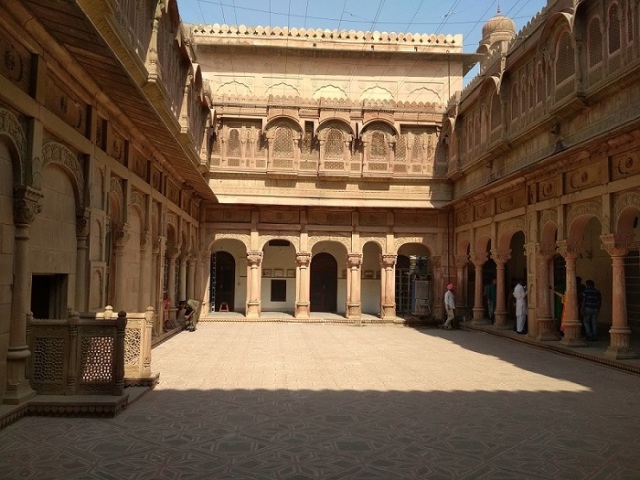 |
| Inside view of Junagarh Fort, Rajasthan, India. Photo: LB Thapa |
By
LB THAPA, lately in Bikaner, Rajasthan, India
After
staying a few days with the family of my younger brother in Delhi, I left for
Mahajan, Rajasthan where my younger brother Lt. Colonel Sudhir Thapa was
posted. I walked around the Mahajan area then one day I was taken for a tank
ride.
Of
course, it was for the first time in my life and I was riding a tank…it was my
lifetime experience.
After
spending two days at Mahajan, my brother made an army jeep available to take me
to Bikaner, Rajasthan.
Throughout
the journey, I was accompanied by Yogesh Bhoite the driver in uniform, and an
army, staff photographer. The army jeep drove fast through the desert, with no human
settlement insight, and the road was straight. While our jeep was moving at its
highest speed, I sporadically spotted several groups of deer sitting under the
shade of bushes here and there.
I
saw foxes and jackals as well. “During the daytime when the sun becomes merciless,
to evade scorching heat, all animals take rest under the sheds of small trees and
bushes. But as soon as the sun sets, these animals become active at night” said
Bhoite, army driver.
It
took nearly two and half hours to reach Bikaner. When we reached Bikaner, Mr.
Sanjay, by profession a lawyer and a prominent businessman in Bikaner, was
waiting to receive me.
Later
I came to know that my brother had asked Mr. Sanjay to take me for a Bikaner
sightseeing. However, I was vastly impressed with Mr. Sanjay…he was down to
earth person…very gentle and extremely frank.
Though
we met for the first time, I felt as if we knew each other for a long time. I
immediately felt comfortable in his company.
“There
are so many interesting things in Bikaner, but Junagarh Fort is the
masterpiece”, emphasized Sanjay proudly.
Before
my visit to Bikaner, I had only read about the Junagarh fort on the internet, but I was
excited because the fort was only a few yards away from me.
So,
ready to visit Junagarh fort with me. How about beginning with a little
history…
Do not copy any photos: All photos by LB Thapa
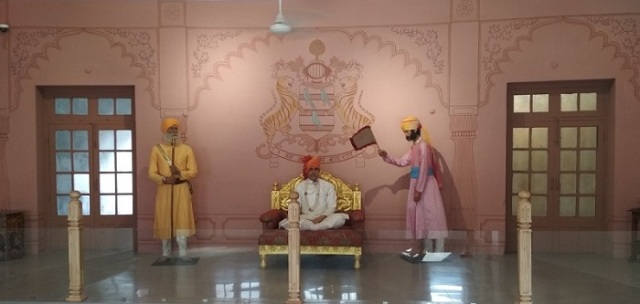 |
| A scene of Royal court. |
 |
| A royal horse drawn cart. Photo: LB Thapa |
 |
| World War I biplane. Photo: LB Thapa |
 |
| Army photographer. Photo: LB Thapa |
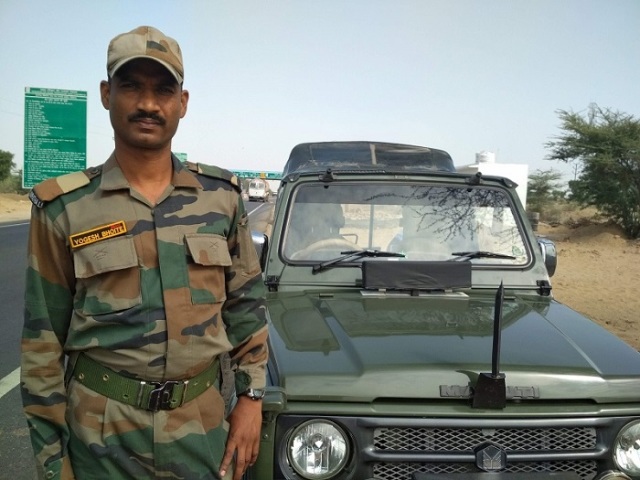 |
| Yogesh Bhoite, an army driver, drove me to Bikaner Rajasthan. Photo: LB Thapa |
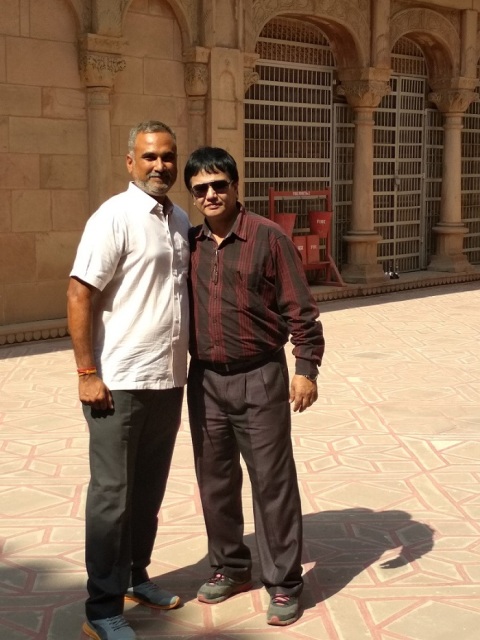 |
| Sanjay, on left, was my host in Bikaner, Rajasthan. Photo: Army staff photographer |
LITTLE HISTORY
Rao
Bika had founded the city of Bikaner in 1472 then he built the fort in 1478.
Later, Raja Rai Singhji, the sixth ruler of Bikaner, ruled Bikaner from 1571 to
1611. During his reign, Raja Rai Singhji completed the building task of the Junagarh fort in 1594.
Raja
Rai Singhji had extensively traveled during his reign. While traveling he took a deep interest in the art and architecture of different places. Later when he was
building the Junagarh fort, he used all this knowledge and experience of the art
into the building of the Junagarh fort.
The
Junagarh Fort has a rectangular layout with a length of 986m. The fort is
spread over 5.28 hectares of area. The fort has 37 bastions and 7 large gates. Two
are the main gates, which were specially designed to trap the enemy.
ENTERING THE FORT
As
soon as entering from the main gate there is a little upward narrow path,
leading to the entrance gate where tickets are checked.
At
present, the entry fee is Rs.50/- per person for Indians, but Rs.300/- for
foreigners. However, Indian students can pay only Rs.30/- whereas foreign
students need to pay Rs.150/-.
Once
tickets are checked by the fort staff, the entire fort is allowed to walk
around. There is a fort guide as well. You don’t have to pay money for his
service as it is already included in the ticket. But, I suggest you don’t join
the group. The guide walks too slowly as he explains every small detail of the
history. Most of the information the guide provides is already available on the internet.
Therefore,
the best thing is you walk yourself and take plenty of pictures. There are so
many beautiful and historic things that you would like to capture with your
camera. Will you believe it? By the time, I completed the fort tour; I had already
clicked over 500 photos…amazing, is it not?
Walking
through the numerous halls within the fort, there displayed several artifacts
and rare items of historical importance. I witnessed a rich stock of history,
which vastly surprised me.
The
entire Junagarh fort is replete with extremely beautiful stone carved in red
and gold-colored sandstones. In fact, a couple of years ago I had been to Alwar
fort, which is also famous for stone carving on red stone among others, but the
stone carvings across Junagarh fort are of a higher level. For most of the
interior decoration of the palaces is done in the traditional Rajasthani style.
Junagarh
fort has several large rooms. It is therefore every item, which belonged to different
kings and their families has been displayed quite systematically. Due to the large
space available, new kings added more rooms as they needed instead of building
a new palace.
THE MAIN GATE TO
ENTER JUNAGARH FORT
Suraj
Pol is the main gate to enter Junagarh fort. The gate is facing east,
greeting the early sunlight, hence it is called Suraj (Sun) gate.
Soon
after entering from the main gate, two large-sized red stone statues of
elephants seem to welcome the visitors. The gate is built at an elevation from
where musicians would play their trumpets and announce the arrival and
departure of royalty.
There
are other gates such as Karan gate, Daulat Gate, Chand gate, and Fateh gate. On
the wall of Daulat gate, there are hand imprints of 41 royalties. The hand
imprints in red color were the wives of the Maharajas of Bikaner who willingly
self-immolated on the funeral pyres of their husbands who achieved martyrdom on
the battlefield.
Before
reaching the royal chambers, there is a gate called the Tripolia gate (triple
gateway). Beside this gate is a Har Mandir. It was the temple where only Royal
families were allowed to worship.
Near
the temple, there is a large pavilion around and a water pool built in the
center…the pool is built in Carrara Italian marble.
Maharaja
Karan Singh used to hold a public audience at Karan Mahal. The tradition was
continued by his successors until the 20th century.
GREAT PALACES IN THE
JUNAGARH FORT
Junagarh
fort is renowned for its remarkable palaces. There are seven most popular palaces
of great historical importance. The visitors to Junagarh fort must not miss
anyone of these palaces, as they are extremely beautiful and historical.
KARAN MAHAL
It
was actually built as Public Audience Hall. This palace was built by Maharaja Karan
Singh in c. 1680 after registering a thumping victory over the Mughal Emperor
Aurangzeb. The palace has several gardens, which augment the aesthetic beauty
of the palace.
The
palace has glass windows and the woodcarvings on columns are done beautifully.
Stone carvings on red stone are awesome. Later Raja Anup Singh and Surat Singh
did use inlaid polychrome glass and intricate mirror patterns. Most of the
wooden frames were painted with red and gold paint.
A
beautifully painted Royal Throne is placed in the coronation chamber. This
throne is the cynosure of all visitors.
PHOOL MAHAL
Phool
Mahal is also called Flower palace. This palace is the oldest among other parts
of the palace. The palace was built by King Raja Rai Singh of Bikaner. He ruled
Bikaner from 1571 to 1668.
ANUP MAHAL
Anup
Mahal is a tall structure. It was served as an administrative headquarters.
This multi-story building is known for its ornate wooden ceilings with inlaid
mirrors, Italian tiles, and lattice windows and balconies. Anup Mahal is
therefore considered one of the most beautiful palaces in Bikaner.
CHANDRA MAHAL
Chandra
Mahal (palace) has large rooms that kept precious objects like gold-plated
deities, precious stones, paintings, etc.
Another
interesting thing about Chandra Mahal is the placement of mirrors. Those mirrors
are placed in such a way that the Maharaja could see anyone before entering his
bedroom.
GANGA MAHAL
Ganga
Mahal is a large hall, which was built in the 20th century by Maharaja
Ganga Singh. He ruled Bikaner from 1887 to 1943. Now, this hall has been
converted into a museum. A large collection of weaponry has been displaced in
this museum.
The
interesting part of this museum is that there is a World War I biplane. Among
the visitors, the biplane is the center of attraction.
BADAL MAHAL
Badal
Mahal or Cloud palace is better known for its paintings of the Shekhawati chief
paying respects to the Maharaja of Bikaner. The people in the paintings are
seen standing on nails and swords. This way they wanted to prove their respect
and allegiance to the Maharaja.
BIKANERI HAVELIES
Some
of the Bikaner havelies are located inside the fort while others are located
out of the fort area. These havelies are famous for their architectural style.
These architectural designs are of the master class. Many historians opine that
Bikaneri Havelies are the pride of Bikaner.
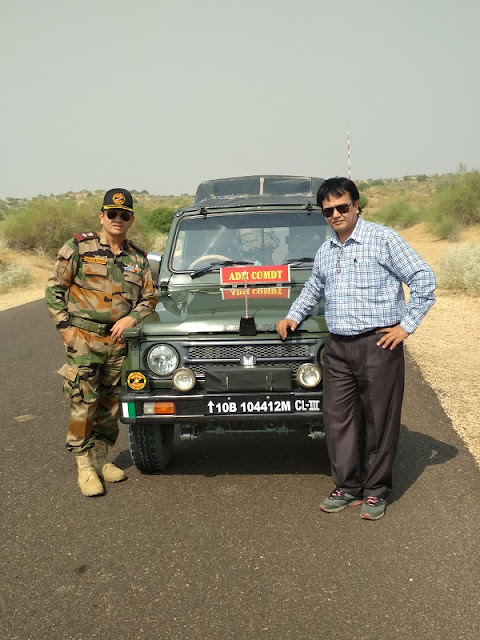 |
| I was with my younger brother Lt. Colonel Sudhir Thapa, on the way to Junagarh Fort. Photo: Army staff photographer |
VISITING THE
JUNAGARH FORT MUSEUM
The
Junagarh Fort Museum is located inside the Junagarh fort itself. This museum
came into existence in 1961 by Maharaja Dr. Karni Singh Ji. The whole
arrangement was made possible under the control of Maharaja Rai Singh Ji Trust.
The
museum has several galleries and each gallery is devoted to one unique thing of
great historical value.
Soon
after entering the museum, the first gallery is devoted to Sanskrit and Persian
manuscripts. The next gallery has accommodated small size paintings. These
paintings are small but they have been meticulously painted by using several
color combinations.
Expensive
jewels are displayed in the adjoining gallery. In a separate gallery there
displayed royal costumes. Due to proper care and maintenance, those costumes
still look quite new and the colors have not faded.
There
is a small gallery where displayed royal orders by different kings of Bikaner.
At the end of this gallery were displayed several idols of Hindu Gods and
Goddesses.
There
is a large gallery where colorful palanquins, which were used by the royal
families, have been displayed. Many of those palanquins have been painted with
bright colors. The clothes used to cover palanquins are also in bright colors. Those
palanquins, which were painted with bright colors, still look anew and fresh.
There is no sign of discoloring neither palanquin wood nor royal clothes.
A
large collection of weapons has been displayed in many galleries. These weapons
had been used by the Maharajas of Bikaner to defend the fort. Small and large
size canons and modern guns have also been displayed in a grandiose manner.
MAHARAJA RAI SINGH
TRUST
The
Royal family of Bikaner has established the museum with the purpose of
displaying the rich wealth of the Maharajas of Bikaner.
Yet
another noble purpose of establishing this museum is to provide easy access to
the rich history of Bikaner to scholars and researchers.
The
museum is open from 10 am to 4.30 pm on all days.
Note: (This article was originally published in Hospitality, Food & Wine magazine)
LEGAL WARNING
All rights reserved. No
articles and photos published in this blog can be reproduced without the prior
written permission of the author. Legal action will be taken immediately if any
articles or photos are reproduced without the author’s knowledge. However,
articles or photos can only be reproduced by duly mentioning the author’s name
and the blog's name (read2bhappy.blogspot.com). The author must be informed by
sending an email. All articles and the photos published in this blog are the
copyright property of LB THAPA
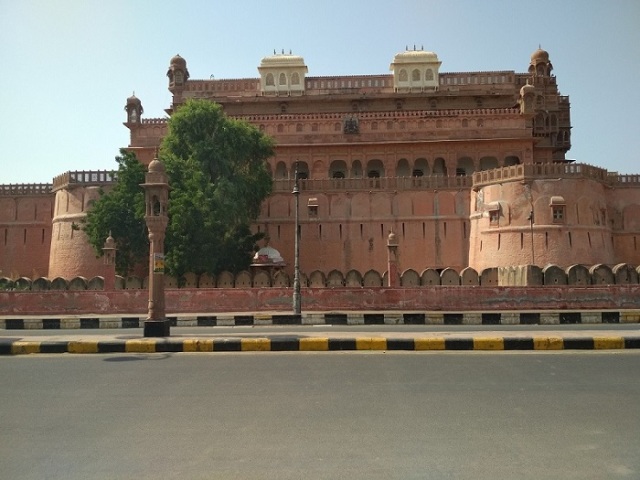




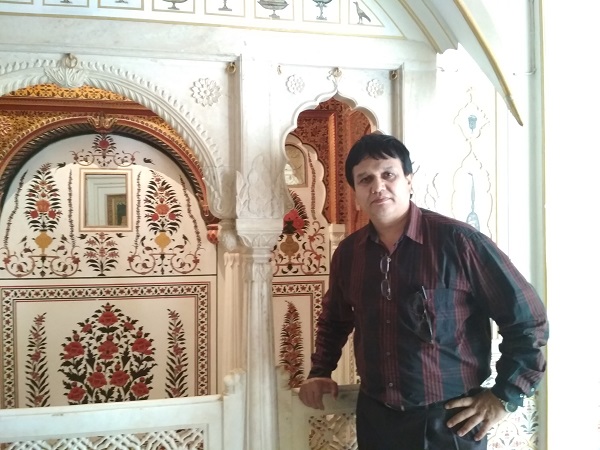




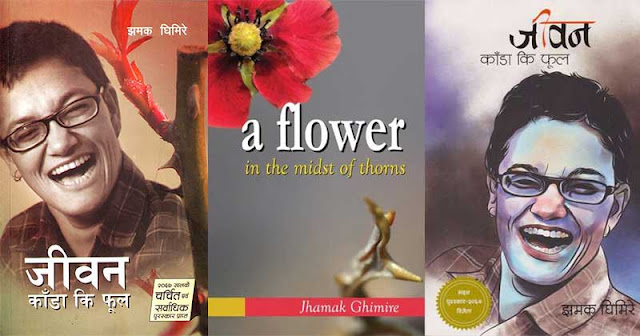




.png)
Comments
Post a Comment